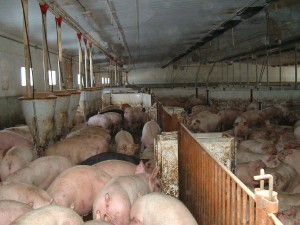With the current shift in the industry toward housing pigs in groups of 100 to 1,000 per pen, questions have been raised as to whether pigs can perform as well in large groups as they do in small ones. Recent work at the Prairie Swine Centre examined how housing finishing pigs in two group sizes and at two floor space allocations affects production, health, behaviour, and physiological variables. The studies looked at the effects of small (18 pigs) vs. large (108 pigs) group sizes provided with 0.52 m2/ pig (crowded) or 0.78 m2/pig (uncrowded) of space on production, health, behaviour, and physiological variables.
 Eight, 7-8 week-long blocks, each involving 288 pigs, were completed. The average liveweight at the beginning of the study was 37.4kg. Overall, average daily gain (ADG) was 1.032 kg/day and 1.077 kg/day for crowded and uncrowded pigs respectively, which was a highly significant difference. Differences between the space allowance treatments were most evident during the final week of study.
Eight, 7-8 week-long blocks, each involving 288 pigs, were completed. The average liveweight at the beginning of the study was 37.4kg. Overall, average daily gain (ADG) was 1.032 kg/day and 1.077 kg/day for crowded and uncrowded pigs respectively, which was a highly significant difference. Differences between the space allowance treatments were most evident during the final week of study.
Pigs in the crowded groups spent less time eating over the eight-week study than did pigs in non-crowded groups. However, average daily feed intake (ADFI) did not differ between treatments. Overall, ADG of large-group pigs was 1.035 kg/day, whereas small group pigs gained 1.073 kg/day. Average daily gain differences between the group sizes were most evident during the first two weeks of the study.
The investigation found that, over the entire study, large groups were less efficient than small groups. Although large-group pigs had poorer scores for lameness and leg scores throughout the eight-week period, morbidity levels did not differ between the group sizes. Minimal changes in postural behaviour and feeding patterns were noted in large groups.
An interaction of group size and space allowance for lameness indicated that pigs housed in large groups at restricted space allowances were more susceptible to lameness. Although some behavioural variables, such as lying postures, suggested that pigs in large groups were able to use space more efficiently, overall productivity and health variables indicate that pigs in large and small groups were similarly affected by the crowding imposed in this study.
The trial indicated no difference in the response to crowding by pigs in large and small groups. Little support was found for reducing space allowances for pigs in large groups.
WHJ comment: There is no doubt that the North American pork industry has enthusiastically embraced large group grow-finish systems in order to obtain the benefits of auto-sorting equipment, which leads to more optimal market weights and saves labour. However, little is known about the implications for pig performance and welfare. This study suggests that space allowance has a bigger effect on growth than group size, although ADG was better for the small groups. The suggestion that pigs in large groups make better use of space and therefore need less space per pig seems to be disproved by this work. Even though there are disadvantages in both performance and some measures of welfare, the trend towards large groups is likely to continue due to the magnitude of the benefits.
Reference: B. R. Street and H. W. Gonyou. – Effects of housing finishing pigs in two group sizes and at two floor space allocations on production, health, behaviour, and physiological variables.
J. Anim Sci. 2008. 86:982-991. doi:10.2527/jas.2007-0449









